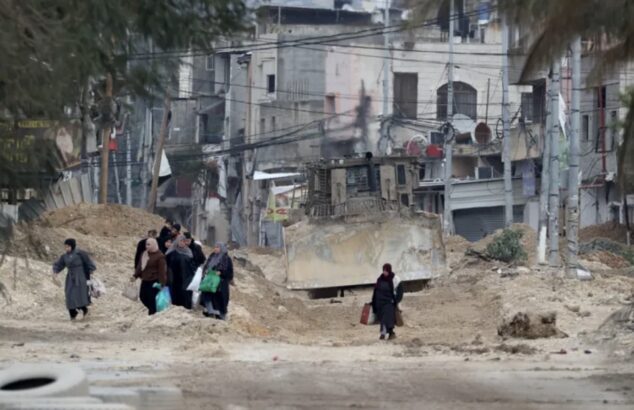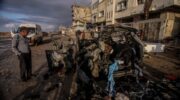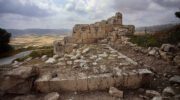Inside the human toll of Israel’s campaign of forcible displacement in the northern West Bank’s refugee camps.
By Leila Warah, Reposted from Mondoweiss, March 20, 2025
On the morning of February 9, the al-Ashqar family sat in terrified silence as news spread of the Israeli military’s advance into their neighborhood in Nur Shams refugee camp in Tulkarem.
Unbeknownst to them, Israeli forces had planted a bomb at their front door — an explosive device that would soon take the life of 21-year-old Rahaf al-Ashqar, one of over 70 Palestinians killed during Israel’s ongoing assault on the northern West Bank.
Her father, Fuad al-Ashqar, recalled to Mondoweiss that he and Rahaf were sitting in the living room when she told him to look out the window. “There are wires on the pillars of the house. What are those wires?” Rahaf had said.
Before he could respond, she sprang from the couch in a panic, running towards the door, shouting, “Baba, they want to blow up the house!”
Moments later, Rahaf was dead.
Both she and her father were knocked to the ground before Fuad heard her final breath.

Fuad, also injured by the blast, was left to bleed out for over 30 minutes while waiting for an ambulance, delayed by the need for Israeli permission.
“If we had waited any longer, [Fuad] would have died too,” his wife, Kifah al-Ashqar, added. “There was so much blood, it looked like it could fill a bucket.”
Soon after, two soldiers entered the house.
“They just stood there, looking. I was terrified, but at that moment, I began screaming at them, telling them they had murdered [Rahaf],” she said. “Not one of them tried to help my husband. They left him there, bleeding on the ground.”
The military ransacked the house, and later, Kifah read in an Israeli newspaper “that they had blown up the house by mistake.” Her frustration was evident.
Following the explosion, the family was forced to flee the refugee camp and seek shelter in a relative’s home. Seventeen people now share a three-bedroom house in the village of Kafa, southeast of Tulkarem.
Unable to return to Nur Shams refugee camp for Rahaf’s burial without Israeli permission, her funeral was delayed for nine days, all while her body was kept in a freezer.

‘Operation Iron Wall’: Israel’s campaign of displacement
The al-Ashqar family, forcibly displaced with 40,000 other Palestinians, is emblematic of the human cost of Israel’s ongoing military assault on the northern West Bank. Dubbed “Operation Iron Wall,” it began in Jenin on January 21, expanded to Tulkarem on January 27, and reached Tubas by February 1.
The Israeli assault has caused the largest displacement of Palestinians in the West Bank since the 1967 war, according to the UN Relief and Works Agency (UNRWA), with the military systematically emptying entire refugee camps.
In Nur Shams refugee camp, the Israeli military kicked Palestinians out of their homes by force, giving no evacuation announcements and instead “moving house by house, emptying each one before advancing,” says Nihad al-Shweish, the head of the Popular Council in Nur Shams refugee camp.
“So eventually, street by street, the camp became deserted,” he tells Mondoweiss.
When the military arrived at his door, they threatened to blow up his house while he was still inside if he didn’t leave.
UNRWA reports that the military is creating an “increasingly dangerous and coercive environment” through the use of airstrikes, armored bulldozers, controlled detonations, and advanced weaponry, which human rights organizations are describing as collective punishment.
The destruction wrought by Israeli forces in the Tulkarem and Nur Shams refugee camps has left displaced residents in deep fear, worried that by the time the military assault ends, there will be nothing left to return to.

The ongoing Nakba
The history of Palestinian refugees living in camps makes Israel’s ongoing campaign of forcible displacement in the north all the more devastating. The residents hail from families forcibly displaced from their lands by Zionist militias in 1948 during the Nakba, which paved the way for the creation of the State of Israel.
“In 1948, we set up tents, built small houses, and struggled to survive,” al-Shweish told Mondowiess. “But we always had one hope that this camp was just a temporary station for our return to our lands in 1948.”

The stories of the Nakba are being echoed today in Tulkarem, where Palestinians are seeking refuge anywhere they can find — whether in the homes of relatives, schools, or mosques.
East of Tulkarem in the village of Kufr Labad, 31-year-old Ayad Ayed Abdullah is seeking shelter in Dhaya Wedding Hall with her husband, five children, and about ten other families.
Sitting on a plastic chair with her 2-year-old daughter in her lap, and surrounded by other displaced women and children living in the wedding hall, Ayad spoke to Mondoweiss about what it means to be the descendant of Nakba survivors in Tulkarem today. “During the Nakba, our grandparents were forced from our homes [near Haifa], and they prayed that we would never endure the same fate,” she said. “But now, here we are.”
“Look at how many people are here and the conditions we’re forced to endure,” she continued, gesturing to the hall, where blankets were hung haphazardly to create a semblance of privacy amidst the stacked sleeping mats and piles of clothing.
When the Israeli military stormed her home in Nur Shams refugee camp on February 10, her husband asked the soldiers, “where are we supposed to go? We have nowhere to go except our home.”

“The soldiers started yelling at us and hit [my husband] in the head with his gun,” Ayad said, explaining that the army gave the family of seven three minutes to pack their things and get out. “What can I get in three minutes? I go to my bedroom, and the soldier follows me; I go to the living room, and he follows me. I couldn’t get anything.”
Ayad and her family fled on foot in the rain, alongside seven other households, including her elderly mother-in-law and several young children as they watched more Israeli military units enter the camp.
After weeks of sleeping in the overcrowded hall, the family attempted to return to their home in the refugee camp, explaining that “we wanted to spend Ramadan in our home.”
Upon their return, they found that “[the military] broke our TVs, ripped our couches, broke our plates, and broke all the doors. They searched and opened everything.”
After two days of living in fear and jumping at every noise, the Israeli military returned to expel them once again.
“They came in, stomping and yelling at us: ‘Why did you come back here? You are not allowed to come here. You have nothing here, this is a closed military zone. Whoever comes here will have their house burned.’”

Netanyahu commandeers Palestinian home as command base
Israel is framing its ongoing invasion as a “counter-terrorism operation” aimed at fighting Palestinian resistance groups, which Israeli Prime Minister Benjamin Netanyahu referred to as “terrorists” during a rare visit to Tulkarem on February 21.
Palestinian resistance groups in the northern West Bank refugee camps are largely composed of young men with limited resources fighting against Israel’s occupation of their land. They reject the label of “terrorists,” instead framing their struggle as a fight for liberation and the right to return to their ancestral homes.
One fighter from Tulkarem, whose family hails from a village near Haifa, told Mondoweiss in October: “I’m fighting the occupation because I want to visit my land one day. Every Palestinian, every person, every refugee has a dream of returning to their land.”
Despite the Israeli military’s claims of targeting only armed resistance groups, Palestinian residents and political leaders insist that everyone and everything is a target.
“[The Israeli] military is using the same strategy here as in Gaza, labeling refugee camps as hubs of resistance. They call these areas ‘terrorist hubs’ to justify their destruction,” says al-Shweish.

During his visit, Netanyahu stormed the home of a Palestinian civilian located just outside the Tulkarem refugee camp, which had been seized by the Israeli military and transformed into a command base for 22 days.
The home belongs to Abdul Lafit Amer, 45, and his family.
On March 14, the day after the Israeli military withdrew from his home, the family gathered to scrub Hebrew graffiti from the walls and clean up the trash left behind by Israeli forces.
Amer told Mondoweiss that he and his family had been forcibly evicted at gunpoint, and when they were finally able to return, they found their home looted and in ruins.
“It was unbelievable,” Amer said, referring to a photo of Netanyahu sitting in his living room. “We were shocked. Someone like that sitting in my house. I put my whole life into this house, and this guy comes and sits in it.”
Amer’s family is now living elsewhere, too afraid to return permanently.
Al-Shweish believes that Israel’s military operation is not about security, but part of a larger agenda to erase refugee camps, which he sees as a living testament to the Nakba and the ongoing crimes of the occupation.
“By erasing the camps, they want to erase the idea that Palestinians have a right to return,” he explained. “But even if the camp is in ruins, we will pitch tents and sleep there. This is the stance of the people. This is not just about buildings, walls, and concrete. Our home is a history, a cause.”
Leila Warah is a freelance multimedia journalist based in Palestine.
RELATED:
- Israeli forces strip and arbitrarily detain two Palestinian children in the occupied West Bank
- Settlers Occupied a Palestinian House in Hebron
- More Israeli settler violence: Palestinians brutally attacked, then interrogated by police
- “Unprecedented escalation” in Israeli settler attacks against Palestinians
- Coming soon: Trump plan for Israeli annexation of the West Bank





